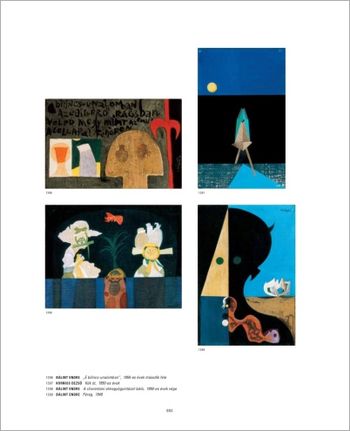
Endre Bálint
Encyclopedia

Hungary
Hungary , officially the Republic of Hungary , is a landlocked country in Central Europe. It is situated in the Carpathian Basin and is bordered by Slovakia to the north, Ukraine and Romania to the east, Serbia and Croatia to the south, Slovenia to the southwest and Austria to the west. The...
painter
Painting
Painting is the practice of applying paint, pigment, color or other medium to a surface . The application of the medium is commonly applied to the base with a brush but other objects can be used. In art, the term painting describes both the act and the result of the action. However, painting is...
and graphic artist.
Biography
He studied poster designing at the School of Applied Arts from 1930 to 1934, then attended the private school of János Vaszary and Vilmos Aba NovákVilmos Aba Novák
Vilmos Aba-Novák was a Hungarian painter and graphic artist. He was an original representative of modern art in his country, and specifically of its modern monumental painting...
. From 1936 he spent several summers in Szentendre
Szentendre
Szentendre is a riverside town in Pest county, Hungary, near the capital city Budapest. It is known for its museums , galleries, and artists. Due to its picturesque appearance and easy rail and river access, it has become a popular destination for tourists staying in Budapest...
, in the company of his friend Lajos Vajda
Lajos Vajda
Hungarian Painter. He was a student of István Csók at the Hungarian Academy of Fine Arts in 1927-30. He studied together with Dezsõ Korniss at Fernand Léger in Paris in 1930-34 where he was introduced to cubism and surrealism....
and artistic peers.
In 1945 he founded the artistic group European School and he painted recollections of World War II
World War II
World War II, or the Second World War , was a global conflict lasting from 1939 to 1945, involving most of the world's nations—including all of the great powers—eventually forming two opposing military alliances: the Allies and the Axis...
in its aftermath with powerful gestures. In 1947 he witnessed as a participant the second surrealistic world expo in Paris. Affected positively by this event, his paintings of the end of the 40s and the beginning of the 50s became populated with mythological creatures: elves, kobolds and anthropomorphic organic creatures. Towards the middle of the 1950s he produced drawings that eventually took him to setting his imagination free - with depictions of a horse-headed mouse, wheel-forms, fragments of Swabian and Arabic female figures.
After periods of staying temporarily in Paris, he lived there on a permanent basis from 1957 to 1961. In 1958 Édition Labergerie published the Jerusalem Bible
Bible
The Bible refers to any one of the collections of the primary religious texts of Judaism and Christianity. There is no common version of the Bible, as the individual books , their contents and their order vary among denominations...
with more than a thousand of Bálint's illustrations, and this aided him in developing his typical late artistic style.
From 1959 onward he painted one after the other his most valued paintings, including the Miraculous Fishing, the Dream in the Public Park and I Walked Here Sometime I-II all in 1960 illustrating a form of late surrealism
Surrealism
Surrealism is a cultural movement that began in the early 1920s, and is best known for the visual artworks and writings of the group members....
. He incorporated memories of his childhood with internal landscapes from his dreams often producing frightening figures and shapes.
By the end of the 60s and the beginning of the 70s the epic nature of this painting had been replaced by the depiction of motifs of symbolic value growing increasingly macabre and grotesque.
Besides his artwork, Balint also had numerous writings and memoirs published in a number of volumes documenting his life in the 1970s and early 1980s. He died in Budapest
Budapest
Budapest is the capital of Hungary. As the largest city of Hungary, it is the country's principal political, cultural, commercial, industrial, and transportation centre. In 2011, Budapest had 1,733,685 inhabitants, down from its 1989 peak of 2,113,645 due to suburbanization. The Budapest Commuter...
in 1986.
Paintings Pre 1960
- My Room at the Bindendorfs 1937
- Self-portrait 1942
- Still-life 1946
- House at Szentendre 1948
- Root Dance 1952
- Stone Bird 1952
- Statue in a Cemetery 1959
- Houses at Hastings 1959
- Homesickness 1959


